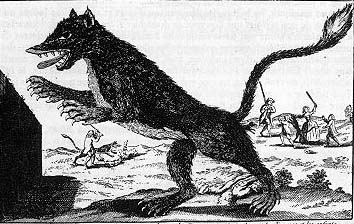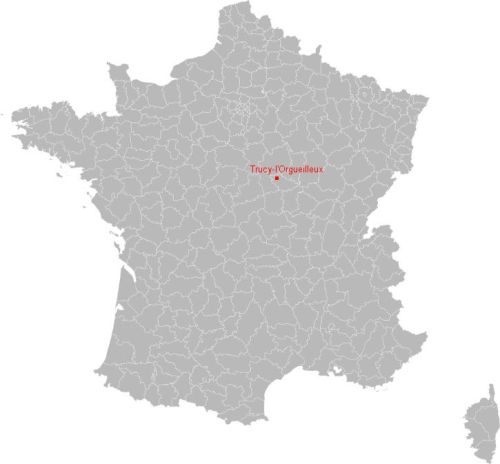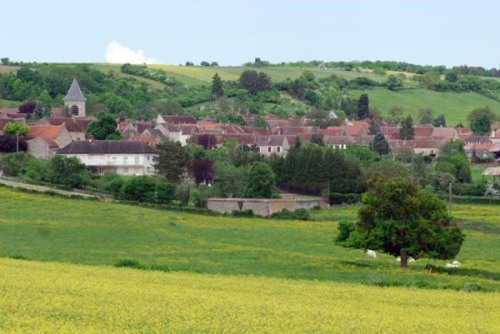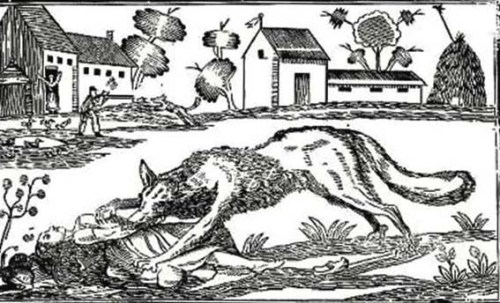After researching “The Beast of Gévaudan”, I was amazed to find that over the centuries, a large number of different areas of France have been ravaged by man-eating creatures, such as the monsters in the countryside around Auxerre, Lyon, Orléans or the Vosges Mountains. On a number of occasions what was probably one single animal might even be called by several different names as it wandered widely around various places. «La Bête des Cévennes », « La Bête du Vivarais » or « La Bête du Gard », for example, were all one and the same monster.
The majority have always been considered wolves, although of course, in our time the wolf no longer seems to behave in this aggressive way. Strangely enough, for a substantial number of these less widely known beasts, the witnesses were often keen to say that it was a wolf but not an ordinary wolf like the ones which they saw virtually every single day. It may have had a wider muzzle, or a belly that dragged on the ground. It may have had pale or even white underparts. Ironically, this latter identification feature on its own actually excludes the wolf as a possibility.
All three of these details, of course, the muzzle, the belly and the underparts were features of the “Beast of all Beasts” in Gévaudan. The peasants, shepherds and shepherdesses were armed only with a stick, or a pole with a knife attached to it, because the lower classes were forbidden to carry firearms, which was the exclusive right of the nobility. Agricultural workers, though, were all highly experienced at identifying wolves. And lightly armed as they were, the population of the average administrative area in rural France in the eighteenth century might still kill a hundred wolves a year between them.
Nowadays, the wolf seems a much calmer animal. They have become extremely rare in Western Europe, and even in Eastern Europe they seem to be less dangerous than old oral traditions would have us believe. Furthermore, it is certainly a fact that only one person has ever been killed by wolves in North America, and even then the wolves involved had become over-habituated to Man through frequent feeding on a landfill site.
The process by which wolves are believed to have become man killers in France is described in a French Wikipedia article, entitled “Le Loup dans la culture européenne”…“The Wolf in European Culture”
….Thanks to the improvements made in the field of agriculture, Man ceaselessly extended his cultivated land and increased the area for his livestock at the expense of woods and forests. The Feudal System and hunting as a leisure pursuit constantly reduced the number of animals to hunt, and attacks by wolves became therefore increasingly frequent. Flocks of sheep were an easy prey item during a period when food was short.
In normal times the wolf does not attack Man and indeed, even when he is hungry he fears human beings, above all when he is forced to confront an upright enemy. Faced by a man, the wolf always backs down or just runs away. Nevertheless wolves in the Middle Ages used to follow men around when they were out at night walking between villages. The wolves always remained a certain distance away from them. Without doubt they were doing this to get food, thinking that the man must be hunting and that they could grab any unwanted food that was left behind. These stories of wolves which followed men at a distance, sometimes over dozens of kilometres, accentuated the phenomenon of fear of the wolf.
However, attacks by wolves on men were reported for the first time towards the end of the Middle Ages, from the time of the Hundred Years War onwards. These attacks also correlate with epidemics of rabies which can change a wolf’s behaviour completely.
At this time of famine the wolf might have started devouring the corpses left behind by the warring armies. Not rabid wolves, but wolves used to the taste of human flesh would have committed acts of predation towards weak human targets. These cases of predation disappeared around 1820 because of the disappearance of open air mass graves from this period onwards. There will always remain nevertheless a small number of isolated attacks linked to epidemics of rabies, but in this case the cause of the illness is easily identifiable.”(My own translation)
Further ideas come from « Mikerynos » writing on his own excellent website. He sees the entire French population as having within them a deep seated fear of the wolf, much as other nations might have traditional fears of people of a different race or cultural background from themselves.
“Nowadays beasts still appear in the French countryside but they only kill sheep or other animals. The most famous of all was the Bête des Vosges in 1977.
Feral dogs, escaped zoo animals, animals trained by malicious pranksters and sometimes wolves are used to explain these episodes.
But the Old Demons are not yet ready to fade away. The arrival of Italian wolves in the Parc National du Mercantour has brought about the raising of a protective shield wall on the part of livestock farmers and hunters, who have not been at all afraid of introducing the question of the danger to human life, for in the collective subconscious of the whole French nation, some monstrous beast can still be seen lurking dimly behind these innocent wolves, which have absolutely no connection whatsoever with it.
Over the course of the centuries in France there have been many other episodes similar to the Beast of Gévaudan, even if they were less blood soaked. And the explanations are always exactly the same. Wolves are the guilty ones.Nowadays all zoologists are in complete agreement with each other that the wolf practically never attacks Man. Indeed on the contrary, the Wolf always flees from Man. The idea that a Wolf is a man eater is essentially a French one which has led some people to deduce that the wolves in France must be the only ones to exhibit such behaviour! In the same way the theme of the werewolf, a man who can change into a wolf, is above all a French one. And The Beast who brings together both of these two themes is, in exactly the same way, as we already said, a very French concept.
In a word, though, it is the fear of untamed nature which shines through these themes, a fear which has become particularly focussed on certain species such as the wolf. Every animal attack which seems beyond rational explanation very quickly leads to gossip and rumours. The Beast of Gévaudan is not the only animal to have spread terror across France. There was “la Bête d’Evreux” (1632-1633), “la Bête de Brives” (1783) and “la Bête du Cézailler” (1946-1951).
The most ferocious seem to have been “la Bête de l’Auxerrois” and “la Bête du Vivarais”.
The former appeared in 1731 and killed 28 victims. It was described as a tiger or a wolf. The “Bête féroce de Sarlat” was famous in Périgord from 1766 onwards. Its peculiarity was not to attack women but to kill exclusively men. In 1814 it was the turn of the « Bête féroce d’Orléans » to achieve a certain success. It ripped to pieces and devoured the poor inhabitants of the countryside, massacred entire families, destroyed and devastated everything which appeared in its path and carried out the most appalling carnage, if one is to believe the caption explaining an etching of the period. A lament was even written about it; the style is not too clever but we can imagine the fear of the audience who were listening to such verses. The official disappearance of the wolf from France came in 1937 when the very last one was killed in Limousin. Or more precisely, the Wolf was presumed extinct insofar as the breeding population was diminishing between 1930 and 1939.
From 1818 to 1829, more than 14,000 wolves were killed in France every year. That was the era of the appearance of the single shot rifle (1830) then there were repeating rifles and the double barrel shotgun. Firearms became henceforth extremely accessible and extremely effective. Wolves could be killed at a range of more than 100 metres. The number of hunting permits awarded just grew and grew. In parallel, the use of poison spread among wolf hunters: monkshood the wolf killer, added to ground glass, meadow saffron, a concoction with tamarack, water hemlock and nux vomica.”
(My own translation)
I have found it a fascinating idea that only two hundred or so years ago a highly developed European country like France could have been repeatedly ravaged by man-eating animals, whether they were wolves or, just plain, simple monsters of the type the Hillbilly Hunters chase after on a weekly basis in the TV show “Mountain Monsters”.
I intend therefore to bring these unknown creatures back into the public eye. Had they been active in an English speaking country, I am sure that they would be a lot more famous than they are now, although, of course, they do appear in a good many French websites on “la cryptologie”. The first one to feature, on a purely alphabetical basis, is the “Bête de l’Auxerrois ou la Bête de Trucy”….
Called by two alternative names, the “Beast of Auxerre” or the “Beast of Trucy” was either one or several man-eating animals which were behind an extensive series of attacks on humans. Nowadays, the tiny village is called “Trucy-L’Orgueilleux”.
The first incident came in November 1731 when a young boy of 12 years old was working close to the wood of Trucy-sur-Yonne to the south of Auxerre with his mother. She managed to snatch him back from the carnivorous animal which was trying to devour him, but he died in her arms as they made their way back home.
Attacks then succeeded each other in such quick succession that King Louis XV offered a reward of £200 to whoever could kill the beast. Beats were organised and numerous wolves were killed. The poisoned carcasses of sheep were left out in the fields but the attacks continued, with young children the principal victims. The beast even ventured into the village of Mailly-la-ville and carried off a young child who was playing in front of his house. Trying to snatch him back from the beast’s fangs, his nurse was only able to recover one of his feet (or just one of his arms according to other witnesses).
Illustrations of the “Beast of Auxerre” or the “Beast of Trucy” seem pretty well non-existent on the Internet. The engraving below appears on one website, but it is also featured elsewhere as being the “Beast of Orléans”…
In five months the local priest of Val-de-Mercy recorded 14 deaths due to the attacks of this carnivorous animal. By the end of the year 1734 a grand total of 28 victims had been listed. The animal supposedly killed a total of nine children, nine women and ten men according to the death certificates which have so far been located. In 1734 two wolves were killed in the course of a hunt and the attacks stopped shortly afterwards. There was however, no irrefutable concrete indication that either of these two animals was behind the attacks which had lasted for three desperate years. Contrary to the Beast of Gévaudan, these killings seem to have concerned as many men as women
In 1817 a second carnivorous beast ravaged the forest around Trucy for a few months, strangely, at the very same place as the animal from eighty years previously. One child was devoured close to Charentenay, another at Fouronnes and numerous people were injured. Poisoned sheep were placed close to the woods and the beast duly disappeared without leaving any trace whatsoever. No carcass was ever found but mercifully the attacks stopped.
This picture allegedly shows the “Beast of Auxerre” or the “Beast of Trucy” but it had previously been used in pamphlets about the Beast of Gévaudan.

For the attacks of 1731–1734, contemporary rumours talked of a werewolf, of several wolves and even of demons. The witnesses spoke of either a huge wolf or a tiger. Following the usual pattern, the witnesses’ descriptions indicated an animal that was “like a wolf” but which nobody thought was just an ordinary wolf. According to the experts nowadays the monster was probably some exotic wild animal which had escaped from its owner, but given the descriptions, it was most probably not a common-or-garden wolf.
Unlike the countryside though, in the towns, certainly, the majority of the people had little idea at all of what a wolf was like. Here is a contemporary picture of a wolf….
For the second series of attacks in 1817, local talk was of a hyena although one statement described a mastiff dog with pointed ears.
It is always worth looking at a second account of what are clearly the same events
“In 1731 there appeared in the woods around Trucy, to the south of Auxerre, a beast which terrorised the region. The first attack was on a boy of twelve in November 1731, very close to the tiny village of Trucy-l’Orgueilleux. The number of victims quickly increased, with 17 in three years, of whom the majority were children. The king offered a reward of £200 to whoever could kill the beast but without result. The creature then continued its carnage until 1734 when it quite simply disappeared without anyone having been able to kill it despite numerous beats being organised. Overall it killed approximately 30 people, the majority of them children.
In 1817 it was a different beast which ravaged again the very same area of Mailly-la-ville and the Forest of Trucy. Described as a tiger or an enormous wolf, people finally concluded that it was a wolf of enormous size and particular ferocity. It killed 28 people (nine children, nine women and ten men) and was never killed despite numerous beats being organised and the poisoned carcasses of sheep being placed randomly in the surrounding area. Like its predecessor this animal just disappeared “back into Nature” so to speak.”
Clearly there has been some confusion between the two websites over victim totals, but it is always best to see at least two variations of the same story. If you want to see more than just these two then go to the French Google and search for either “La Bête de Trucy” or “la Bête de l’Auxerrois”.
“…a mother grabbed her twelve year old son from the jaws of an enormous beast without managing, alas, to save him… After this they killed a number of wolves, but the beast continued to attack young children, women and men…… 28 victims were eventually listed. Then they killed a couple of wolves, and the attacks ceased. People talked of werewolves, of wolves gone mad, and even of Demons. Witnesses spoke of the “Beast like a Wolf” but actually “Not a Wolf”. The experts nowadays tend to speak of a wild animal, but seldom of a mere wolf.”
At least one other website which lists “The Monsters That Ravaged France” clearly places “La Bête de Trucy ou la Bête de l’Auxerrois” not in the category of the wolf but in that of the “bête mystérieuse”.
These same details are given by that great expert, « Mikerynos » in the very first article on the page….
“(Elle) est apparue en 1731 et a fait 28 victimes. Elle est décrite comme un tigre ou comme un loup.”
What is most striking about “La Bête de Trucy ou la Bête de l’Auxerrois”, though, is the sheer number of victims consumed. In English we say “as hungry as a wolf”. I don’t know if the French have an equivalent but if they do, it should probably relate to Trucy or Auxerre!








